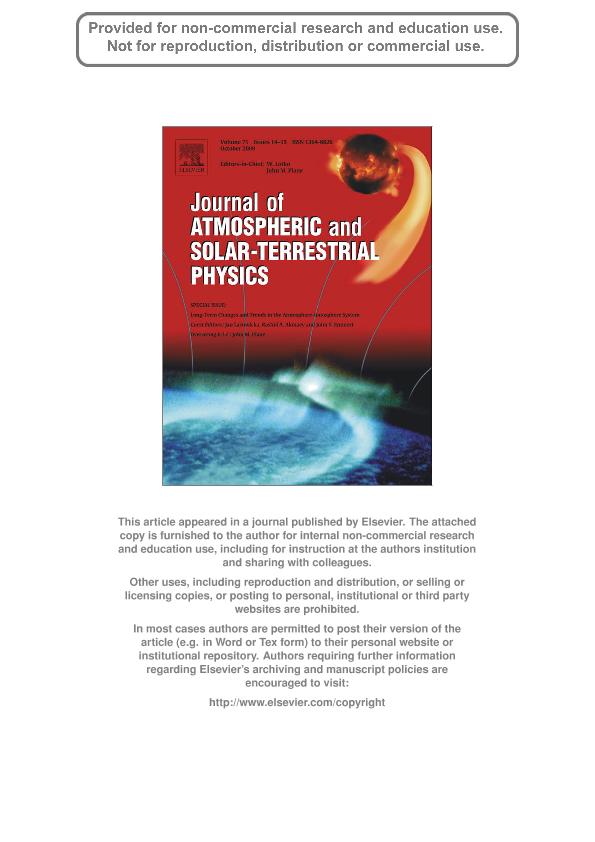Mostrar el registro sencillo del ítem
dc.contributor.author
Mansilla, Gustavo Adolfo

dc.contributor.author
Fernández de Campra, Patricia
dc.contributor.author
Zossi Artigas, Marta Maria

dc.date.available
2019-05-20T12:46:28Z
dc.date.issued
2009-12
dc.identifier.citation
Mansilla, Gustavo Adolfo; Fernández de Campra, Patricia; Zossi Artigas, Marta Maria; Quasi-biennial oscillation in foF2 at the south crest of the equatorial anomaly; Elsevier; Journal of Atmospheric and Solar-Terrestrial Physics; 71; 14-15; 12-2009; 1610-1612
dc.identifier.issn
1364-6826
dc.identifier.uri
http://hdl.handle.net/11336/76693
dc.description.abstract
The aim of this paper is to report some periodicities observed in the ionospheric parameter foF2 measured at Tucuman (26.9°S; 65.4°W), station placed near the southern crest of the equatorial anomaly. For that, monthly medians of foF2 at several hours of LT for the period 1958–1987 are used. The data are run with Fast Fourier Transform (FFT). Data gaps (∼4–5 months) are filled by means of linear interpolation. Several periodicities are present. Besides the solar cycle dominant dependence (∼11 years), semi-annual, annual, five years and quasi-biennial periodicities are also observed. A marked quasi-biennial periodicity is observed at daytime and nighttime hours being their greater amplitude at local noon and midnight. Different mechanisms or combined effects possibly cause them. It is suggested that the solar activity by means of extreme ultraviolet radiation (EUV), which present a quasi-biennial oscillation (QBO) and it is responsible for the ionization, could be the dominant mechanism for the diurnal quasi-biennial periodicity of foF2. At night, since the photoionization by extreme ultraviolet radiation is not significant and the F2 layer is lower than during daytime (∼100 km) other mechanism may be operative for the quasi-biennial periodicity observed. Possibly the stratospheric QBO contributes to the modulation of the observed behaviour in foF2 at night. This result is preliminary because it needs to be extended to other stations so as to extract definite conclusions. Moreover, we cannot dismiss the possibility of a combined effect of both these mechanisms mainly at daytime and/or QBO influence of geomagnetic parameters.
dc.format
application/pdf
dc.language.iso
eng
dc.publisher
Elsevier

dc.rights
info:eu-repo/semantics/openAccess
dc.rights.uri
https://creativecommons.org/licenses/by-nc-sa/2.5/ar/
dc.subject
Ionosphere
dc.subject
Equatorial Anomaly
dc.subject
Quasi-Biennial Oscillation
dc.subject.classification
Meteorología y Ciencias Atmosféricas

dc.subject.classification
Ciencias de la Tierra y relacionadas con el Medio Ambiente

dc.subject.classification
CIENCIAS NATURALES Y EXACTAS

dc.title
Quasi-biennial oscillation in foF2 at the south crest of the equatorial anomaly
dc.type
info:eu-repo/semantics/article
dc.type
info:ar-repo/semantics/artículo
dc.type
info:eu-repo/semantics/publishedVersion
dc.date.updated
2019-05-06T14:14:52Z
dc.journal.volume
71
dc.journal.number
14-15
dc.journal.pagination
1610-1612
dc.journal.pais
Reino Unido

dc.journal.ciudad
Londres
dc.description.fil
Fil: Mansilla, Gustavo Adolfo. Universidad Nacional de Tucumán; Argentina. Consejo Nacional de Investigaciones Científicas y Técnicas. Centro Científico Tecnológico Conicet - Tucumán; Argentina
dc.description.fil
Fil: Fernández de Campra, Patricia. Universidad Nacional de Tucumán; Argentina
dc.description.fil
Fil: Zossi Artigas, Marta Maria. Universidad Nacional de Tucumán; Argentina. Consejo Nacional de Investigaciones Científicas y Técnicas. Centro Científico Tecnológico Conicet - Tucumán; Argentina
dc.journal.title
Journal of Atmospheric and Solar-Terrestrial Physics

dc.relation.alternativeid
info:eu-repo/semantics/altIdentifier/doi/https://dx.doi.org/10.1016/j.jastp.2009.03.003
dc.relation.alternativeid
info:eu-repo/semantics/altIdentifier/url/https://www.sciencedirect.com/science/article/pii/S1364682609000510?via%3Dihub
Archivos asociados
